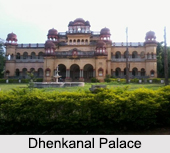 Dhenkanal is an urban area in district headquarters town of the Dhenkanal district located in the eastern state of India, Odisha. Dhenkanal is famous for its wonderful Dhokra art and this city has many educational centers for the graduates and the post graduates.
Dhenkanal is an urban area in district headquarters town of the Dhenkanal district located in the eastern state of India, Odisha. Dhenkanal is famous for its wonderful Dhokra art and this city has many educational centers for the graduates and the post graduates.
Location of Dhenkanal
Dhenkanal is strategically located on the National Highway 42; (NH 42). Dhenkanal is well connected to the major towns of the state. Bhubaneshwar, the state capital city is located at a distance of 100 km. from Dhenkanal.
History of Dhenkanal
Dhenkanal was once the Princely State of India, when British East India Company began to rule after the decline of Maratha Empire. The royal state of Dhenkanal was formed in medieval era by Gajapati Empire ruler Maharaja of Utkal Sri Sri Pratap Rudra Deb. In 1529, Dhenkanal emerged as the administrative capital in Odisha. In 1700, the Rajas of Dhenkanal saw the revolts against the state by the peasants and farmers. They seek the help from the British Empire in India, and they helped the Rajas of Dhenkanal for suppressing the revolt. Praja Mandal Movement after that was closely associated with Indian National Congress and then this princely state became the seat of Indian Independence Movement. 
Geography of Dhenkanal
Dhenkanal is located between 20.67 degree North latitude and 85.6 degree East longitude. It is situated at a height of 80 meters above mean sea level.
Demography of Dhenkanal
According to the Population Census in the year 2011, Dhenkanal had a population of 67,414. The males in the urban area of Dhenkanal constitute 53 percent of the population and females are 47 percent. The average literacy rate is about 79 percent, which is higher than the national average of 59.5 percent. The male literacy are in Dhenkanal is 84 percent and female literacy rate is 74 percent.
Education of Dhenkanal
Dhenkanal is also the home of some eminent educational institutions like IIMC, NYSASDRI School of Journalism & Social Work, Dhenkanal College, Synergy Institute of Engineering & Technology, Vidyarthee Residential College and many more.
Tourism in Dhenkanal
Dhenkanal is named because earlier it was in possession of the Savar chief Dhenka. Dhenkanal is dotted with numerous Hindu temples and several archaeological sites now maintained by Archaeological Survey of India. Some of the important temples of Dhenkanal are Balabhadra temple, Sambhugopal temple, Raghunath temple and Kunajakanta Krishna temple, Shanichara temple, Sidha Ramachandi temple, Nadhara, Goukanekeswar Mandir, Baladeva Jeu Mandir, Kunjakanta temple, Sundarasuni Mandir, Dakhinakali Mandir, Kapilash Temple, Sita-Ram Mandir, Mahima Alekha Gadi, Sai Temple, Budheswar Temple, Parmeswar Temple, Satsang Srimandir and Annakoteshvara Temple. Dhenkanal Science Center and the Deer Park are the other places of tourism importance in Dhenkanal. Joranda and Kapilasa Wildlife Sanctuary are the nearby destinations.
Visiting Information
Dhenkanal railway station serves Dhenkanal. Dhenkanal lies on NH 42. There are frequent buses from Bhubaneswar, Kolkata and Rourkela.



















